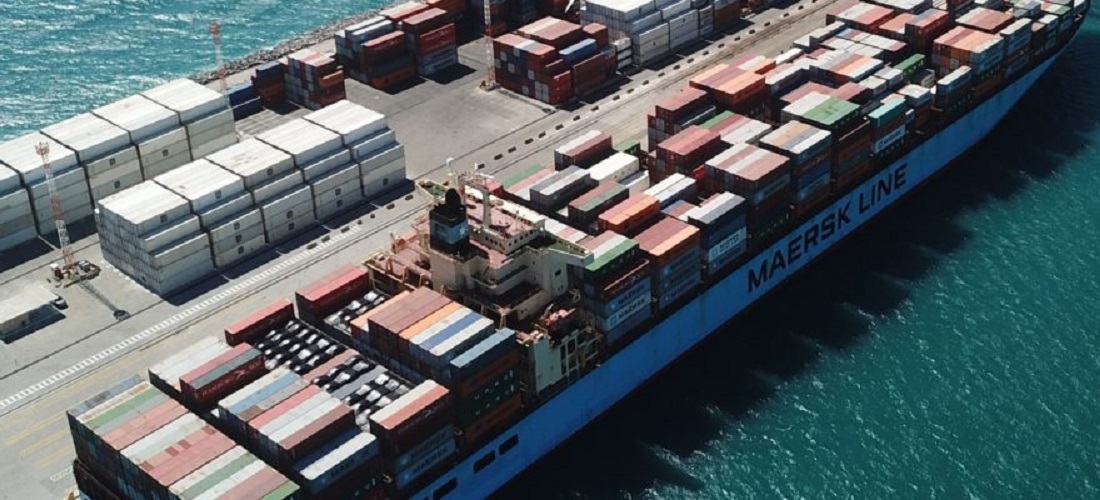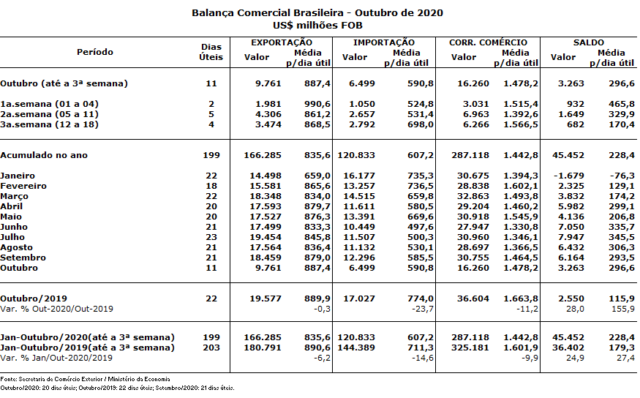
Brazilian trade balance registers US$682m surplus in 3rd week of October
Oct, 19, 2020 Posted by Ruth HollardWeek 202043
Data released this Monday, October 19, by SECEX (the Foreign Trade Secretariat of the Ministry of Economy), points out that the Brazilian balance of trade registered a surplus of US$ 682 million and a trade flow of US$ 6.27 billion in the third week of October 2020 – with four working days – as a result of exports worth US$ 3.47 billion and imports of US $ 2.79 billion.
In the year, exports totaled U$ 166.29 billion and imports totaled US$ 120.83 billion, with a positive balance of US$ 45.45 billion and a trade flow of US$ 287.12 billion.
Month Analysis
In exports, comparing the daily average up to the third week of October 2020 (US$ 887.39 million) with that of October 2019 (US$ 889.86 million), there was a decrease of – 0.3%, due to the decreased Agriculture sales (-17.2%). This was offset by an increase in sales of products from the manufacturing industry (+ 1.9%) and in the extractive industry (7.5%).
The drop in exports was mainly driven by the decreased sales of the following agricultural products: soy (- 36.6%); raw cotton (- 25.1%); live animals, not including fish or crustaceans (- 53.0%); unground corn, except sweet corn (- 1.3%) and non-oil fruits and nuts, fresh or dried (- 4.9%). The daily average of imports up to the third week of October 2020 (US$ 590.78 million) was -23.7% below the October 2019 average (US$ 773.97 million). Expenses fell mainly in the agriculture industry (- 0.8%), the extractive industry (- 37.5%), and the manufacturing industry (- 23.7%).
The decrease in imports was mainly driven by the decreased purchases of the following manufacturing products: iron or steelworks and other articles of common metals (- 80.3%); fuel oils from petroleum or bituminous minerals, except crude oils, (- 49.8%); fertilizers or chemical fertilizers, except crude fertilizers, (- 24.4%); taps, valves and similar devices for plumbing, boilers, reservoirs, vats and other containers (- 41.3%), and automotive vehicle parts and accessories (- 43.9%).
The decrease in imports in the extractive industry was mainly driven by the decrease in spending on: copper ores and concentrates (- 78.7%); crude petroleum or bituminous mineral oils, raw (- 37.8%); coal, even in powder, but not agglomerated (- 23.4%); other base metal ores and concentrates (- 81.6%), and crude fertilizers, except organic fertilizers (- 36.7%).
The decrease in imports in the agricultural sector is mainly driven by the decrease in spending on: latex, natural rubber, balata, gutta-percha, guaiúle, chicle, and natural gums (- 48.2%); whole fish alive, dead, or chilled (- 22.3%); unground corn, except sweet corn (- 21.6%); vegetables, fresh or chilled (- 8.8%), and raw vegetable materials (- 20.9%).
-
Ports and Terminals
Dec, 18, 2019
0
Port of Vitória will receive liquid bulk terminal
-
Ports and Terminals
Jan, 16, 2020
0
Rio Grande do Norte port authority posts positive results after four decades
-
Meat
Nov, 24, 2021
0
Tereza Cristina calls China’s decision to overturn the veto on Brazilian beef exports “the first step”
-
Meat
Jan, 21, 2021
0
China authorizes resumption of Brazilian exports from meat packers JBS and Aurora



